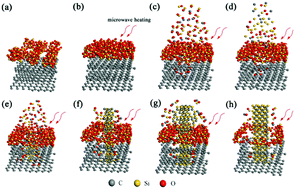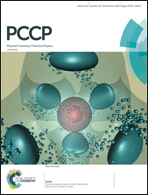Investigation on the growth mechanism of SiC whiskers during microwave synthesis
Abstract
Silicon carbide (SiC) whiskers with different morphologies are fabricated by microwave heating of SiO2-coated coal mineral particles at different temperatures and different holding times in an oxygen-containing environment. The atomic diffusion processes and growth mechanism of the SiC whiskers are simulated. It is found that a closed capsule of SiO2 appears during microwave heating, within which the SiC whiskers are formed. SiC crystals can be prepared at 1100 °C for 10 min. The optimized synthesis condition is approximately 1100 °C for 20 min. Higher temperatures or/and holding times lead to the re-oxidation of the SiC crystals. A layer of amorphous SiO2 wraps around the SiC whisker surface and generates coated composites at all temperatures. Crystallite knots are observed embedding on the SiC whiskers at 1300 °C due to the surface cleaning and activating effects of microwave plasma. The knots are smoothed at 1500 °C due to local atomic diffusion and grain growth motivated by the microwave coupling effect. The variations in the microwave plasma and the coupling effect at different heating stages also give rise to unique growth phenomena. For the sample synthesized at 1100 °C for 20 min, the high permittivity values present in the SiC whiskers lead to the excellent EM absorption properties at high frequency.



 Please wait while we load your content...
Please wait while we load your content...